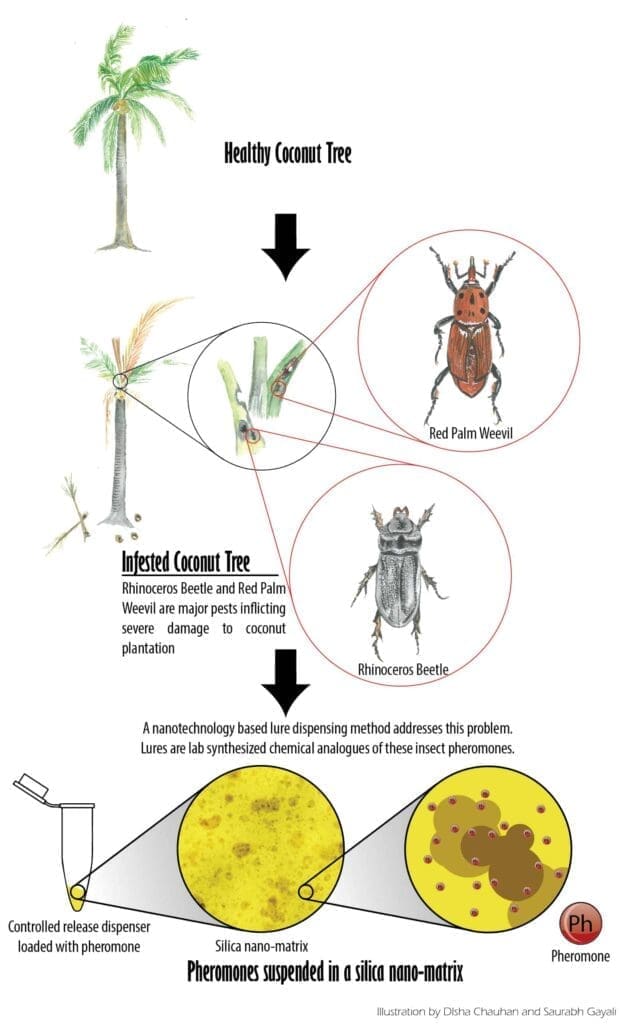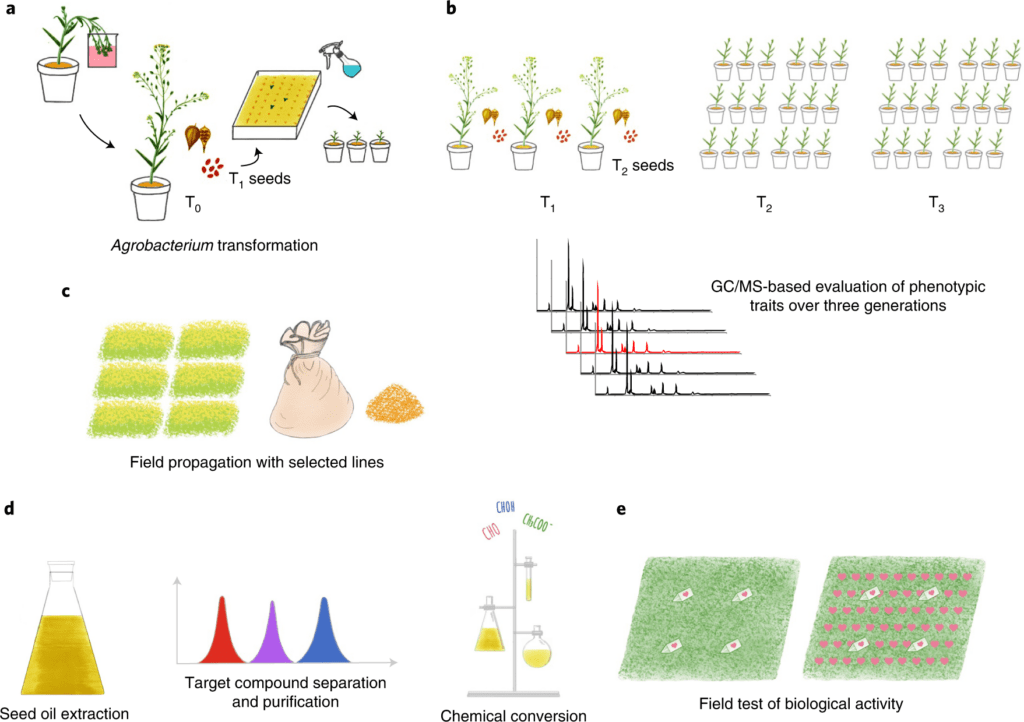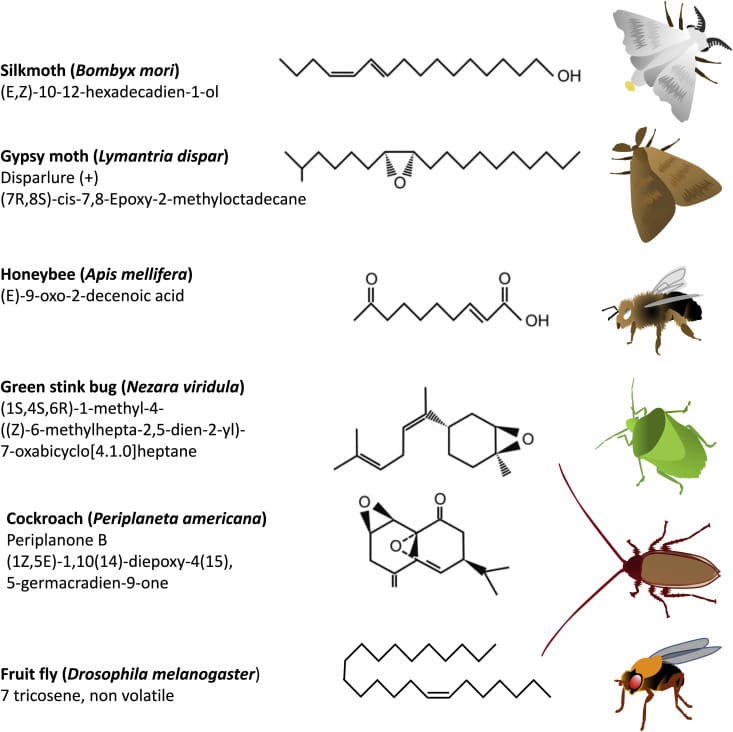In this article, you will discover the fascinating world of pheromones and their powerful impact on pest control. Pheromones, the chemical substances emitted by animals and insects to communicate with one another, have proven to be a valuable tool in managing and eradicating pests. By understanding the science behind pheromones, we can tap into their potential to attract, repel, or disrupt the behavior of pests, ultimately creating a more effective and environmentally-friendly approach to pest control. So, get ready to explore the captivating realm of pheromones and their role in helping us keep those pesky critters at bay.

What are Pheromones?
Pheromones are chemical substances that are naturally produced and released by organisms in order to communicate with others of the same species. These chemical signals play a vital role in various social and reproductive behaviors, including attracting mates, marking territory, and warning of danger. In the context of pest control, pheromones can be used to manipulate the behavior of pests and control their populations effectively.
Definition of pheromones
Pheromones can be defined as chemical messengers that are released by an organism into the environment, which can then be detected by other members of the same species. These chemical signals transmit information and elicit specific behavioral responses, allowing for communication and coordination within a population.
Types of pheromones
There are several different types of pheromones, each serving a specific purpose in the communication and behavior of organisms. Some of the most common types of pheromones include:
-
Aggregation pheromones: These pheromones attract individuals of the same species to a common location, often used in pest control to lure pests into traps.
-
Alarm pheromones: Released in response to a threat or danger, these pheromones alert other members of the species to the presence of a nearby predator or disturbance.
-
Sex pheromones: These pheromones play a crucial role in mate attraction and reproduction, helping organisms find suitable mates and initiate the mating process.
-
Trail pheromones: Often used by social insects like ants and termites, trail pheromones help guide other members of the colony towards food sources or new nesting sites.
How pheromones work
Pheromones work by triggering specific behavioral responses in organisms that detect them. When a pest encounters a pheromone, it can influence its behavior by either attracting or repelling the pest. For example, aggregation pheromones can be used to lure pests into traps, while alarm pheromones can cause pests to disperse or avoid certain areas.
Pheromones are detected by specialized sensory receptors, which are often located on the antennae or other body parts of the organism. Once detected, these receptors send signals to the insect’s nervous system, triggering a specific behavioral response. This response can vary depending on the type of pheromone and the species of pest being targeted.
Pheromones in Pest Control
Pheromones have become a valuable tool in the field of pest control, offering a more targeted and environmentally friendly approach to managing pest populations. By utilizing the natural communication systems of pests, pheromones can disrupt their behavior, reduce their reproductive success, and prevent infestations from spreading.
Overview of using pheromones in pest control
In pest control, pheromones are commonly used in several ways. They can be used to monitor pest populations, attract pests to traps, disrupt mating patterns, or even confuse pests to prevent them from finding food or shelter. By understanding the specific pheromones used by pests, pest control professionals can develop effective strategies to manage and control infestations.
Benefits of using pheromones
Using pheromones in pest control offers numerous benefits. Firstly, pheromones are species-specific, meaning they can target a particular pest species while leaving beneficial insects unharmed. This targeted approach minimizes the use of broad-spectrum pesticides, reducing the risk of environmental damage and the potential harm to non-target organisms.
Furthermore, pheromones are often more cost-effective and efficient compared to traditional pest control methods. By using pheromone traps or dispensers, pests can be lured away from sensitive areas or concentrated in specific locations, making monitoring and control more manageable.
Effectiveness of pheromones in pest control
The effectiveness of pheromones in pest control can vary depending on the pest species, the specific pheromone used, and the application technique. In some cases, pheromones can significantly reduce pest populations, prevent mating, and disrupt pests’ ability to locate resources. However, pheromones may not provide complete eradication of pests, and their effectiveness should be considered in conjunction with other pest control strategies.

Common Pests Controlled by Pheromones
Pheromones have proven to be effective in controlling a wide range of pests. Here are some examples of popular pests and the use of pheromones in their control:
Pheromone control for ants
Ants are social insects that communicate using pheromones. By using ant-specific pheromones, such as trail pheromones or alarm pheromones, pest control professionals can disrupt their foraging patterns, locate nests, and use pheromone baits or traps to control their populations effectively.
Pheromone control for cockroaches
Cockroaches are known as resilient pests, but pheromones can be effective in their control. By using sex pheromones or aggregation pheromones, cockroaches can be lured into traps or deterred from infested areas.
Pheromone control for mosquitoes
Mosquitoes are carriers of numerous diseases and can be a significant nuisance. Pheromones can play a role in controlling mosquito populations by attracting them to traps or disrupting their mating patterns using sex pheromones or alarm pheromones.
Pheromone control for termites
Termites are highly social insects that rely on pheromones for communication and coordination within their colonies. By using termite-specific pheromones, pest control professionals can locate termite colonies, disrupt their foraging patterns, and implement targeted control measures.
Pheromone control for rodents
Rodents, such as rats and mice, can cause extensive damage and pose health risks. Pheromones can be used to attract rodents to traps or repel them from specific areas using species-specific pheromones or predator scent-based solutions.
Pheromone Traps
Pheromone traps are a common method used in pest control to monitor, capture, and control pests. These traps utilize the attractive power of pheromones to lure pests into a device where they can be captured or eliminated.
How pheromone traps work
Pheromone traps work by releasing synthetic pheromones that mimic those produced by pests. These pheromones attract pests, and once inside the trap, the pests are captured and unable to escape. Pheromone traps can significantly reduce pest populations and disrupt their mating patterns.
Types of pheromone traps
There are various types of pheromone traps available, each designed to target specific pests. Some common types of pheromone traps include sticky traps, bait stations, and funnel traps. The choice of trap depends on the pest being targeted, the desired control method, and the specific needs of the situation.
Benefits of using pheromone traps
Using pheromone traps offers several benefits in pest control. Firstly, they are highly effective in capturing pests, allowing for the monitoring and control of infestations. Pheromone traps are also environmentally friendly, as they specifically target pests without harming beneficial insects or disrupting the ecosystem. Additionally, pheromone traps are relatively easy to use, making them accessible to both professionals and homeowners for effective pest management.

Using Pheromones in Integrated Pest Management (IPM)
Integrated Pest Management (IPM) is an approach to pest control that combines various strategies to effectively manage pests while minimizing the use of pesticides. Pheromones play a crucial role in IPM programs by providing a targeted, eco-friendly, and sustainable solution.
Role of pheromones in IPM
In an IPM program, pheromones are used as a component of a comprehensive pest management strategy. By integrating pheromone-based control methods, pests can be targeted specifically while reducing reliance on broad-spectrum pesticides. Pheromones help monitor pest populations, control mating behavior, and disrupt pest movement and feeding patterns.
Combining pheromones with other pest control methods
Pheromones can be combined with other pest control methods to enhance their effectiveness. For example, pheromone traps can be used in combination with cultural practices, such as sanitation or habitat modification, to control pests effectively. By using multiple strategies, a holistic approach to pest management can be achieved.
Advantages of incorporating pheromones in IPM
Incorporating pheromones in an IPM program offers several advantages. Firstly, it reduces the reliance on chemical pesticides, minimizing the potential environmental and health risks associated with their use. Secondly, pheromones are highly targeted, reducing the impact on non-target organisms. Finally, the use of pheromones in IPM programs promotes sustainable pest management practices by reducing reliance on traditional pest control methods.
Commercial Pheromone Products
Various commercial pheromone products are available in the market, catering to different pest control needs. These products are designed to target specific pests and provide effective control solutions.
Overview of commercially available pheromone products
Commercial pheromone products range from pheromone traps and dispensers to pheromone-based repellents and mating disruptors. These products are often developed based on extensive research and testing to ensure their efficacy and safety in pest control.
Popular brands and manufacturers
Several popular brands and manufacturers specialize in producing high-quality pheromone products for pest control. These brands include BioCare, Safer Brand, SC Johnson, and BASF. It is essential to choose products from reputable brands to ensure their effectiveness and reliability.
Factors to consider when choosing pheromone products
When selecting pheromone products, there are several factors to consider. Firstly, the specific pest and its pheromone detection abilities should be taken into account. Secondly, the product’s formulation, such as traps, dispensers, or sprays, should align with the control strategy. Finally, it is crucial to ensure that the product is registered for use in the target location and complies with local regulations.

Application Techniques
The successful application of pheromones in pest control requires proper techniques to maximize their effectiveness. Various application methods and considerations should be taken into account.
Different application methods for pheromones
Pheromones can be applied using different methods, depending on the desired outcome and the target pest. Common application methods include trap placement, spraying pheromone-based solutions, or utilizing dispensers to release pheromones over time. The choice of application method should be based on the pest’s behavior, habitat, and the specific goals of the pest control program.
Placement of pheromone traps
When using pheromone traps, proper placement is crucial for their effectiveness. Traps should be positioned near the pest’s entry points, nesting sites, or areas of high pest activity. Regular monitoring and adjustment of trap locations may be necessary to optimize their capture rate and control efficacy.
Dosage and timing considerations
The dosage and timing of pheromone applications are essential factors to consider. The correct amount of pheromones must be used to achieve the desired effect without saturating the environment. Additionally, pheromone applications should coincide with the target pest’s activity period to ensure maximum attraction and disruption of their behavior.
Safety and Environmental Concerns
While pheromones are generally considered safe and environmentally friendly, some considerations should be taken regarding their use in pest control.
Potential risks of using pheromones
When using pheromones, there is a minimal risk to human health and the environment. However, it is essential to handle pheromone products with caution and follow the manufacturer’s instructions to minimize any potential risks. Some individuals may experience mild allergic reactions, so proper personal protective equipment (PPE) should be used when applying or handling pheromones.
Impact of pheromones on beneficial insects
Pheromones are species-specific and primarily target pests, minimizing the impact on beneficial insects. However, it is crucial to consider their potential indirect effects on the ecosystem. For example, disrupting the mating patterns of pest insects may affect predators or parasitoids that rely on those pests for their survival. Careful monitoring and evaluation are necessary to ensure that pheromone-based control measures do not inadvertently harm beneficial organisms.
Eco-friendly aspects of pheromone-based pest control
One of the main advantages of pheromone-based pest control is its eco-friendly nature. By reducing reliance on broad-spectrum pesticides, pheromones help protect the environment by minimizing chemical residues and reducing harm to non-target organisms. Additionally, pheromone traps are often reusable, reducing waste and promoting sustainable pest management practices.

Future of Pheromones in Pest Control
Continued research and advancements in pheromone technology hold great promise for the future of pest control.
Advancements in pheromone research
Ongoing research in the field of pheromones aims to improve understanding and utilization of these chemical signals. Advances in pheromone synthesis, formulation, and delivery systems are enhancing the efficacy and efficiency of pheromone-based pest control methods.
New applications and innovations
Researchers and industry professionals are continuously exploring new applications and innovations in pheromone-based pest control. This includes the development of novel formulations, improved trap designs, and the identification of pheromones for previously difficult-to-control pests. These advancements are expanding the range of pests that can be effectively managed using pheromones.
Potential challenges and areas for improvement
While pheromone-based pest control has shown immense potential, there are still challenges to overcome. Some pests may be less responsive to pheromone-based control methods, requiring alternative approaches. Additionally, the cost of pheromone products and the availability of specific pheromones for certain pest species may limit their widespread adoption. Continued research and collaboration between scientists, industry, and pest control professionals are essential to address these challenges and improve the efficacy of pheromone-based pest control.
Conclusion
Pheromones play a crucial role in pest control, offering a targeted and environmentally friendly solution to managing pest populations. By utilizing the natural communication systems of pests, pheromones can disrupt their behavior, reduce reproductive success, and prevent infestations from spreading. The use of pheromones in pest control provides numerous benefits, including targeted pest management, reduced reliance on broad-spectrum pesticides, and sustainable pest control practices. While pheromone-based pest control is not a standalone solution, it can be effectively integrated into comprehensive pest management programs, such as Integrated Pest Management (IPM). With ongoing research and advancements in pheromone technology, the future holds great potential for further improvements in pest control strategies.

I am Randy, the author behind PestControld.com. Drawing from decades of experience, I aim to provide valuable insights, expert advice, and practical recommendations to help you make informed decisions when assessing viable pest control solutions.